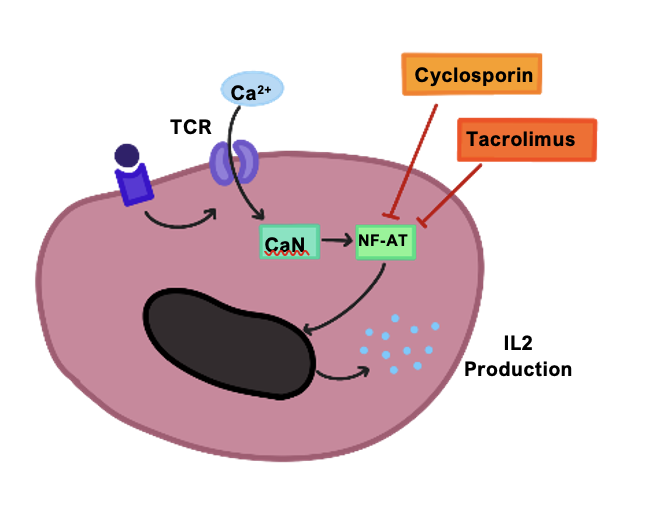Immunosuppressants
These drugs are used to dampen down the immune system which is essential in the management of several inflammatory and autoimmune conditions.
The first line drugs are steroids, but these cannot be used long term due to side effects, and so specific drugs for the condition have been discovered and used.
Non-specific lymphocyte drugs
These drugs cause a depletion in the numbers of both T and B cells. They usually have a lower therapeutic index than specific lymphocyte drugs.
Cyclophosphamide
This is an alkylating agent which was originally developed as an anti-cancer drug.
It is very reactive and forms a positive ion which allows it to bind the oxygen/nitrogen atoms in bases to cause crosslinking of the DNA.
Side effects
Myelosuppression (neutropenia)
SIADH
Hemorrhagic cystitis (as broken down to irritant acrolein) – This is prevented with MESNA, which binds and inactivates acrolein
Transitional Cell Carcinoma (usually in the bladder)
Methotrexate
This is an inhibitor of dihydrofolate reductase which inhibits folic acid synthesis.
Before starting treatment, it is important to do a set of baseline blood tests including FBC, U&Es and LFTs. Blood tests should be measured at regular intervals.
Patients usually take folic acid in conjunction with methotrexate, which is given as a 5 mg once weekly, 24 hours after methotrexate dose.
Side effects
Myelosuppression
Mucositis
Liver/Lung fibrosis
In order to counter the side effects of this, patients are given Leucovorin/Folinic acid, a folic acid precursor with can be converted to tetrahydrofolate without DHFR enzyme. This helps target the toxicity to cancerous cells and used to “rescue” from methotrexate toxicity
Contraindications
Cannot be given with trimethoprim or co-trimoxazole due to bone marrow aplasia
Women should avoid pregnancy for 6 months after treatment
Azathioprine
This is a prodrug which is broken down in a series of reactions into metabolites.
These metabolites inhibit new purine synthesis needed to make DNA.
It inhibits T/B cell proliferation as they cannot make nucleotides from intermediates.
It is eliminated by the enzyme xanthine oxidase, so doses are reduced if the patient is on allopurinol, which is a xanthine oxidase inhibitor.
Side effects
Bone marrow suppression
Pancreatitis
Mycophenolic Acid
This drug also inhibits the synthesis of purines in T and B cells.
It is used for immunosuppression in autoimmune disorders and in transplants.
Side effects
GI disturbances
Neutropenia
TPMT levels
With both azathioprine and mycophenolic acid, it is essential to check the levels of the enzyme TPMT
This is because this enzyme helps break down these components into mercaptopurine, which is the activate metabolite which stops purine synthesis.
Some people may have a genetic deficiency of TPMT (thiopurine methyltransferase)
Therefore, these people are at great risk of developing severe, potentially life-threatening bone marrow toxicity when treated with conventional doses of azathioprine or mercaptopurine.
Specific lymphocyte drugs
These drugs work by inhibiting the activation of T or B cells.
When the T cell receptor (TCR) gets stimulated, Ca2+ ions enter the cell.
Calcium entry activates the phosphatase calcineurin (CaN).
CaN removes a phosphate from NF-AT which moves to nucleus.
This leads to increased transcription of IL-2.
IL-2 binds other T cells, activating mTOR (cell cycle protein).
This leads to T cell clonal expansion resulting in an upgraded immune response.

Cyclosporin
This binds a protein called cyclophilin (CpN), which binds NF-AT, stopping its translocation to the nucleus.
Its main use is to reduce organ rejection in transplants.
Side effects
Nephrotoxicity (hyperkalaemia)
Hypertension
Gingival hyperplasia
Tremor/seizures
Tacrolimus
This prevents NF-AT from being dephosphorylated by calcineurin.
This stops NF-AT translocating to the nucleus preventing IL-2 transcription.
The side effect profile is similar to cyclosporin.
Side effects
Similar to ciclosporin
Sirolimus
This inhibits the mTOR protein which mediates the cell cycle and protein synthesis
It decreases T cell activation and proliferation and is used in transplants and coronary stents.
Side effects
Growth factor inhibition – bad wound healing
Increased triglyceride levels
Basiliximab/Daclizumab
This is a monoclonal antibody against CD25, a subunit of the IL-2 receptor
This inhibits T cell activation and clonal expansion.
Side effects
Hypersensitivity reactions
Rituximab
This is a monoclonal antibody directed against CD20, a marker of B cells.
It causes depletion of B cells and is used in conditions like rheumatoid arthritis, autoimmune conditions and large B cell non-Hodgkin’s lymphoma.
Non-lymphocytic immunosuppressant drugs
These drugs do not directly target T and B cells, but downregulate other chemicals involved in the immune system. They are used more generally for rheumatic diseases.
Penicillamine
This is a metabolite of penicillin which acts as a metal chelator
It has immunosuppressant activity but also used in heavy metal poisoning
Hydroxychloroquine
This is an antimalarial which has immunosuppressant activity.
Anti-TNFa drugs
These sequester and bind TNFa, which is upregulated in rheumatoid arthritis
Adalimumab (Humira), infliximab
These are monoclonal antibodies targeted against TNF alpha.
Etanercept
This is a fusion protein of TNFa receptor + IgG Fc portion, which sequesters TNFa
Apremilast
Apremilast inhibits the activity of phosphodiesterase type-4 (PDE4)
This suppresses pro-inflammatory mediator synthesis and promotes anti-inflammatory mediators.
It is a specialist drug which is used in psoriatic arthritis
Anakinra
This acts as a IL-1 receptor antagonist used against rheumatoid arthritis.
Tocilizumab
This is a monoclonal antibody against IL-6 receptor, an acute phase protein, used in arthritis.
Disclaimer




